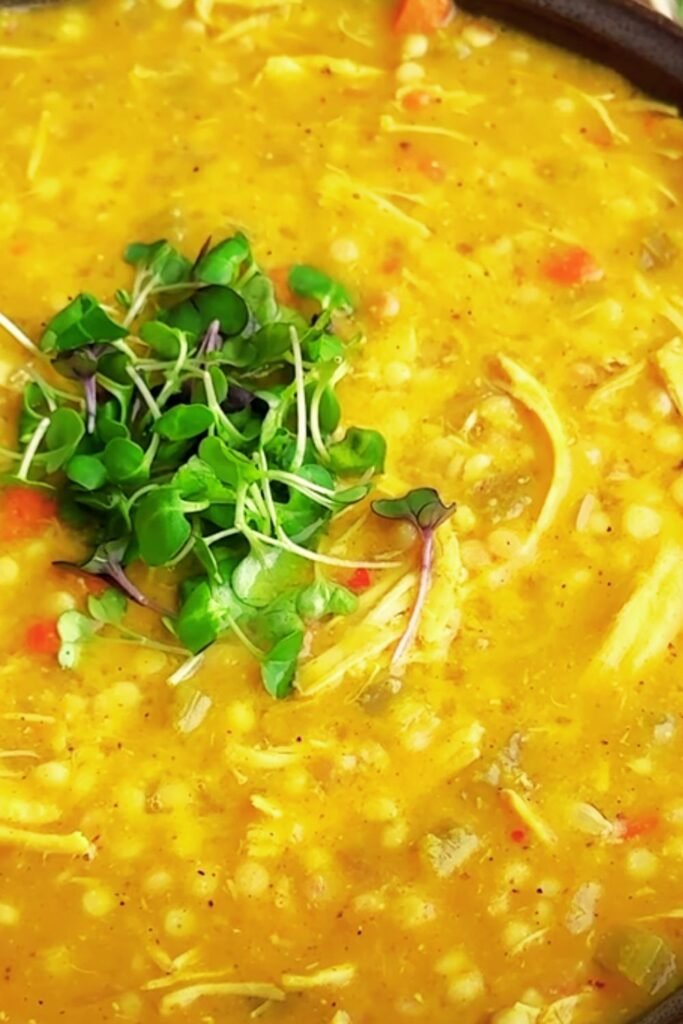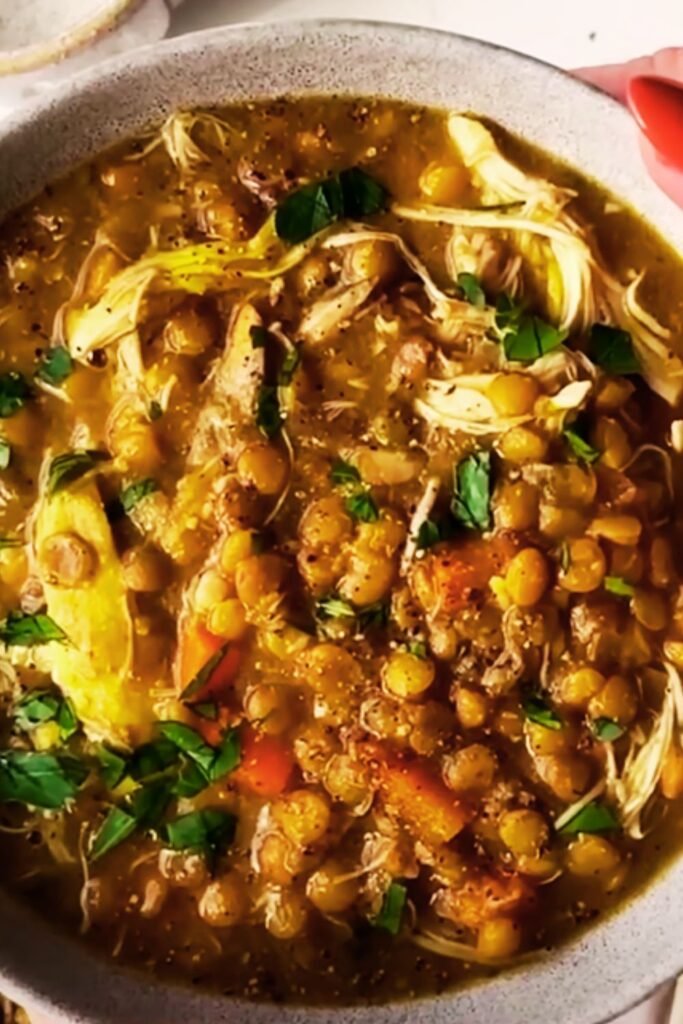There’s something magical about the way aromas fill my kitchen when I’m preparing traditional Algerian soup. The combination of tender lentils, succulent chicken, and vibrant vegetables creates a symphony of flavors that transports me straight to the bustling markets of Algiers. This isn’t just any ordinary soup – it’s a celebration of North African culinary heritage that has been warming hearts and homes for generations.
I’ve spent years perfecting this recipe, learning from Algerian grandmothers who shared their secrets with me during my travels through the Maghreb region. What makes this soup truly special is its perfect balance of protein, fiber, and vegetables, all simmered together with aromatic spices that create layers of complex flavors. Whether you’re looking for a nutritious weeknight dinner or want to impress guests with an authentic North African dish, this soup delivers on all fronts.
Understanding Algerian Cuisine: The Heart of Maghreb Cooking
Before diving into the recipe, let me help you understand what makes Algerian cuisine so distinctive. This North African country sits at the crossroads of Mediterranean, Arab, and Berber influences, creating a unique culinary identity that’s both familiar and exotic.
Harissa: A fiery chili paste that’s the soul of North African cooking, made from dried chilies, garlic, and spices
Ras el hanout: A complex spice blend that can contain up to 30 different spices, literally meaning “head of the shop”
Chorba: The Arabic word for soup, which encompasses various hearty, broth-based dishes
Merguez: Spicy lamb or beef sausages often used in Algerian cooking
Couscous: While not used in this soup, it’s the national dish and often served alongside hearty soups
Preserved lemons: Salt-cured lemons that add a unique tangy flavor to many dishes
The Nutritional Powerhouse Behind This Soup
What I love most about this soup is how it perfectly balances nutrition with flavor. Lentils provide an excellent source of plant-based protein and fiber, while chicken adds complete proteins and essential amino acids. The vegetables contribute vitamins, minerals, and antioxidants that support overall health.
Let me break down the nutritional benefits for you:
| Ingredient | Key Nutrients | Health Benefits |
|---|---|---|
| Red Lentils | Protein (18g per cup), Fiber (15g), Folate, Iron | Supports heart health, stabilizes blood sugar, aids digestion |
| Chicken Thighs | Complete proteins, B vitamins, Selenium, Phosphorus | Muscle maintenance, immune support, bone health |
| Tomatoes | Lycopene, Vitamin C, Potassium, Folate | Antioxidant properties, skin health, heart support |
| Carrots | Beta-carotene, Fiber, Vitamin K, Potassium | Eye health, immune support, anti-inflammatory |
| Onions | Quercetin, Sulfur compounds, Vitamin C | Anti-inflammatory, heart health, immune support |
| Cilantro | Vitamin K, Antioxidants, Essential oils | Detoxification, digestive health, antimicrobial properties |
| Turmeric | Curcumin, Manganese, Iron | Anti-inflammatory, brain health, joint support |
| Ginger | Gingerol, Magnesium, Potassium | Digestive health, anti-nausea, anti-inflammatory |
Essential Ingredients for Authentic Flavor
Creating an authentic Algerian soup requires specific ingredients that work together harmoniously. I’ve learned that substitutions can work, but nothing beats the original components when you want that true North African taste.
Primary Ingredients:
- Red lentils (1½ cups): I prefer red lentils because they cook quickly and break down slightly, creating a naturally thick, creamy texture
- Chicken thighs (1.5 lbs, bone-in, skin-on): The bone and skin add incredible flavor and richness to the broth
- Yellow onions (2 large): These provide the aromatic base that’s essential in Algerian cooking
- Carrots (3 large): Cut into chunks for texture and natural sweetness
- Celery stalks (3 medium): Adds depth and a subtle herbal note
- Canned tomatoes (28 oz): I use San Marzano when possible for their sweet, rich flavor
- Fresh cilantro (1 large bunch): Both stems and leaves are used for maximum flavor
- Fresh parsley (½ bunch): Adds brightness and color

Spice Blend:
- Ground turmeric (2 teaspoons): Provides the beautiful golden color and earthy flavor
- Ground cumin (1½ teaspoons): Essential for that warm, nutty taste
- Ground coriander (1 teaspoon): Adds citrusy, slightly sweet notes
- Sweet paprika (1 tablespoon): For color and mild pepper flavor
- Ground ginger (1 teaspoon): Adds warmth and slight heat
- Cinnamon stick (1 piece): Provides subtle sweetness and complexity
- Bay leaves (2 large): For aromatic depth
Flavor Enhancers:
- Garlic (6 cloves): Minced for maximum flavor distribution
- Tomato paste (3 tablespoons): Concentrates the tomato flavor
- Olive oil (¼ cup): Use good quality extra virgin for best results
- Chicken broth (6 cups): Homemade preferred, but quality store-bought works
- Lemon juice (from 2 lemons): Added at the end for brightness
- Salt and black pepper: To taste
Step-by-Step Cooking Method
My approach to this soup involves building layers of flavor, which is what separates a good soup from an extraordinary one. Each step serves a purpose in developing the complex taste profile that makes this dish so memorable.
Phase 1: Preparing the Foundation
- Heat the olive oil in a large, heavy-bottomed pot over medium-high heat. I prefer using a Dutch oven because it distributes heat evenly and retains warmth beautifully.
- Season the chicken thighs generously with salt and pepper. This step is crucial because it seasons the meat from the outside in.
- Brown the chicken pieces skin-side down first, about 5-6 minutes per side. Don’t rush this step – proper browning creates the fond that will flavor your entire soup.
- Remove chicken and set aside on a plate. The rendered fat and crispy bits left in the pot are liquid gold for flavor.
Phase 2: Building the Aromatic Base
- Add diced onions to the same pot with the chicken fat. Cook for 6-8 minutes until they become translucent and slightly caramelized.
- Add minced garlic and cook for another minute until fragrant. Be careful not to burn it.
- Stir in tomato paste and cook for 2-3 minutes. This step concentrates the tomato flavor and removes any raw taste.
- Add all the dry spices (turmeric, cumin, coriander, paprika, ginger) and stir constantly for 30-60 seconds until fragrant. This blooms the spices and releases their essential oils.

Phase 3: Creating the Soup Base
- Pour in the canned tomatoes with their juice, breaking them up with your spoon as you add them.
- Add chicken broth gradually, scraping up any browned bits from the bottom of the pot.
- Return chicken thighs to the pot along with any accumulated juices.
- Add the cinnamon stick and bay leaves, then bring the mixture to a boil.
- Reduce heat to low, cover partially, and simmer for 25-30 minutes until chicken is tender and easily shreds.
Phase 4: Adding Vegetables and Lentils
- Remove chicken thighs carefully and set aside to cool. Once cool enough to handle, remove skin and bones, then shred the meat into bite-sized pieces.
- Add red lentils to the simmering broth and cook for 10 minutes.
- Add carrots and celery to the pot and continue cooking for another 15-20 minutes until vegetables are tender and lentils have mostly broken down.
- Return shredded chicken to the pot and simmer for 5 more minutes.
Phase 5: Final Seasoning and Fresh Herbs
- Remove cinnamon stick and bay leaves from the soup.
- Stir in chopped cilantro and parsley, reserving some for garnish.
- Add fresh lemon juice and taste for seasoning. Adjust salt, pepper, and lemon juice as needed.
- Let the soup rest for 10 minutes before serving to allow flavors to meld.
Customization Options and Variations
One of the beautiful aspects of this soup is its adaptability. Throughout my years of making it, I’ve discovered numerous ways to modify the recipe while maintaining its essential character.
Protein Variations:
Lamb Substitute: Replace chicken with lamb shoulder for a richer, more traditional flavor. Increase cooking time by 15-20 minutes.
Vegetarian Version: Omit chicken entirely and add an extra cup of lentils plus diced zucchini and bell peppers.
Seafood Twist: Add firm white fish or shrimp during the last 5 minutes of cooking.
Spice Level Adjustments:
Mild Version: Reduce or omit the ginger and add a pinch of sweet cinnamon.
Spicy Version: Add harissa paste (1-2 tablespoons) or diced jalapeños with the onions.
Aromatic Enhancement: Include a pinch of saffron soaked in warm broth for luxury and fragrance.
Vegetable Modifications:
Root Vegetable Addition: Include diced turnips, parsnips, or sweet potatoes for earthier flavors.
Green Vegetable Boost: Add spinach, kale, or Swiss chard during the last 5 minutes.
Summer Version: Include diced zucchini, bell peppers, and fresh corn kernels.

Storage and Reheating Guidelines
This soup actually improves with time, making it perfect for meal prep and batch cooking. I often make a large pot on Sunday and enjoy it throughout the week.
| Storage Method | Duration | Temperature | Notes |
|---|---|---|---|
| Refrigerator | 4-5 days | 32-40°F | Store in airtight containers |
| Freezer | 3-4 months | 0°F or below | Leave 1-inch headspace |
| Meal Prep Portions | 3-4 days | 32-40°F | Individual containers work best |
Reheating Instructions:
Stovetop Method: Transfer to a pot and reheat over medium-low heat, stirring occasionally. Add broth if needed to achieve desired consistency.
Microwave Method: Heat in 1-minute intervals, stirring between each, until thoroughly warmed.
From Frozen: Thaw overnight in refrigerator, then reheat using stovetop method.
Serving Suggestions and Accompaniments
The beauty of this soup lies in its versatility as both a standalone meal and part of a larger feast. In Algeria, soups like this are often served as the centerpiece of the meal, accompanied by various sides that complement the flavors.
Traditional Accompaniments:
Crusty bread: Fresh baguette or Algerian khubz for dipping and soaking up the flavorful broth.
Flatbread: Warm pita or naan provides a perfect vehicle for enjoying every drop.
Rice pilaf: Basmati rice cooked with saffron and almonds makes an elegant side.
Roasted vegetables: Eggplant, zucchini, and bell peppers drizzled with olive oil and herbs.
Modern Serving Ideas:
Over grains: Serve over quinoa, bulgur, or brown rice for added nutrition and heartiness.
With yogurt: A dollop of plain Greek yogurt adds cooling contrast and extra protein.
Cheese garnish: Crumbled feta or goat cheese provides tangy richness.
Avocado slices: For a modern twist that adds healthy fats and creamy texture.
Garnish Options:
- Fresh herb sprigs (cilantro, parsley, or mint)
- Lemon wedges for extra brightness
- Drizzle of good olive oil
- Toasted pine nuts or almonds
- A sprinkle of sumac for tartness
Frequently Asked Questions
Q: Can I use green or brown lentils instead of red lentils?
Yes, but you’ll need to adjust the cooking time significantly. Green and brown lentils take 45-60 minutes to cook and won’t break down as much as red lentils, resulting in a different texture. If using these varieties, I recommend soaking them overnight and adding them earlier in the cooking process.
Q: What’s the best way to prevent the lentils from becoming mushy?
Red lentils naturally break down during cooking, which helps thicken the soup. If you prefer more intact lentils, add them during the last 15 minutes of cooking and monitor closely. However, the slight mushiness is traditional and creates the soup’s characteristic creamy texture.
Q: Can I make this soup in a slow cooker or pressure cooker?
Absolutely! For a slow cooker, brown the chicken and sauté the aromatics first, then transfer everything to the slow cooker and cook on low for 6-8 hours. For a pressure cooker, use the sauté function for the initial steps, then pressure cook for 12 minutes with natural release.
Q: How can I make this soup gluten-free?
This soup is naturally gluten-free as written. Just ensure your chicken broth is certified gluten-free, as some commercial broths contain gluten-containing additives.
Q: What if I can’t find some of the spices?
The core flavors come from turmeric, cumin, and paprika, so these are essential. You can substitute ground coriander with ground fennel, and if you don’t have all the spices, a pre-made Moroccan or Middle Eastern spice blend can work in a pinch.
Q: Is it normal for the soup to thicken significantly when cooled?
Yes, this is completely normal due to the lentils and natural starches. When reheating, simply add more broth or water to achieve your desired consistency. The flavor will remain just as delicious.
Q: Can I prepare parts of this recipe ahead of time?
Definitely! You can prep all vegetables, measure spices, and even brown the chicken a day ahead. The soup also tastes even better the next day, so making it completely ahead is actually recommended.
Q: How do I know when the chicken is properly cooked?
The chicken is done when it easily shreds with a fork and reaches an internal temperature of 165°F. Don’t worry about overcooking slightly – the long simmer time ensures tender, flavorful meat.
Q: What’s the secret to getting the most flavor from this soup?
The key is building layers of flavor: properly browning the chicken, blooming the spices, and not rushing any step. Also, letting the soup rest for 10-15 minutes before serving allows all the flavors to meld beautifully.
Q: Can children enjoy this soup, or is it too spicy?
This soup is generally mild and child-friendly. The spices provide warmth and flavor rather than heat. If you’re concerned, you can reduce the ginger slightly or serve with a dollop of yogurt to cool any perceived spiciness.
This Algerian soup with lentils, chicken, and vegetables represents the heart of North African home cooking – nourishing, flavorful, and deeply satisfying. Every time I make it, I’m reminded of the power of simple ingredients transformed through time, patience, and love into something truly special. Whether you’re seeking comfort food, exploring new cuisines, or looking for a healthy meal that doesn’t compromise on taste, this soup delivers on every level.
The recipe serves as a perfect introduction to Algerian cuisine while providing a complete, nutritious meal that feeds both body and soul. From the first spoonful to the last, you’ll understand why soups like this have been treasured in North African households for centuries.